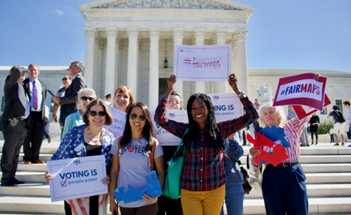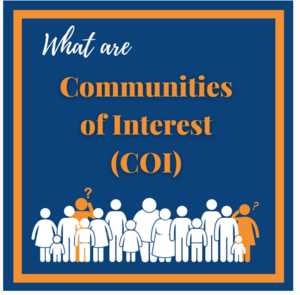[What is Redistricting] [Why] [State Level ] [ Local Level] [Communities of Interest] [Redistricting Glossary] [RECORDING of Day of Action]

Redistricting
Most of our federal legislators, all of our state legislators, and many of our local elected officials in counties and towns are elected from districts. Most of the time, district lines subdivide territory, so that there are several districts within one county, city, special district or state, and a representative for each district. When that happens, we need some way to decide where the district lines will be drawn.
What is Redistricting
Redistricting is the way we change the districts that determine who represent us. Every ten years, the US census is taken and political constituency district boundaries are redrawn based on the Census results.
The United States Constitution requires that political districts of the same type have the same number of residents. This is called the principle of Population Equality. At every level of redistricting, this is the first rule that has to be followed with only very small variations in population per district.
 Why Redistricting Matters
Why Redistricting Matters
Political and racial gerrymandering distorts and undermines representative democracy by allowing officials to select their voters rather than voters to elect their officials. When done for purposes of racial discrimination or to ensure the dominance of one political party, gerrymandering runs counter to equal voting rights for all eligible voters. Congressional districts and government legislative bodies should be apportioned substantially on population. LWV opposes partisan and racial gerrymandering that strips rights away from voters.
Once drawn, our maps determine how we're represented in the government for the next ten years. This means all state and local decisions on health care, jobs, the environment, education, and more rely on fair maps.
The League is committed to ensuring that maps are drawn fairly and accurately, with all voices considered and equitably represented. This can only be achieved, with voices from all communities. The 2021 redistricting cycle will create maps that states and local entities will use in their elections for the next 10 years. That is why it is crucial that redistricting processes provide ample opportunity for public testimony. This allows members of the public to provide valuable information to the mapmakers about their community (where it is located, who lives there, and why it is important that the community is kept whole ) and to provide feedback on draft or final maps. This Communities of Interest input is essential.
To help with understanding a number of terms associated with Redistricting, the League has developed a Redistricting Glossary.
What the League of Women Voters is doing
We promote transparent and accountable redistricting processes and to end hyper-partisan practices that don't benefit constituents. We believe responsibility for fair redistricting should be vested in an independent special commission, with membership that reflects the diversity of the unit of government. The League works in states across the country to pass ballot initiatives to institute independent redistricting commissions.
People Powered Fair Maps is a national redistricting program of the League of Women Voters focused on creating fair political maps nationwide in all 50 states + D.C. In June of 2019, the US Supreme Court ruled in Rucho v. League of Women Voters of North Carolina that no fair test exists for courts to determine when partisan gerrymandering has gone too far. As a result, federal courts will be hands-off in the redistricting process even when new district lines are drawn to intentionally decrease the voting power of voters based solely on their political party.
State Level Redistricting in California
In anticipation of the 2010 Census and redrawing of districts, Californians passed two propositions that took the process out of the legislative bodies and transferred the task to an independent citizens commission. The Voters FIRST Act gave this power to California citizens ensuring that new and fair political boundaries are drawn without special interests, politics and political influence. The California Citizens Redistricting Commission, made up of 14 California Citizens, draws the district lines for United States Representatives, California Senate and Assembly and the State Board of Equalization Districts.
The new 14-member 2020 CA Citizens Redistricting Commission is fully formed. As required by law, the first eight members of the 2020 Citizens Redistricting Commission were randomly selected. These first eight members chose the final six members from the applicants that remained in the applicant pool.
Due to the delay in Census data, the Commission has new timelines when the final maps must be presented to the Secretary of State for certification. Note: Updated Timeline.
State redistricting: WeDrawTheLines.
See:Redistricting in California

Local Level Redistricting in Butte County
Local redistricting involves any county, city, school district, community college district, or special district that is divided into districts or divisions. These local governments are required to review their current district boundaries and redistrict based on new population figures from the census. Following the creation of the California Citizens Commission in 2010 at the State level, the Legislature passed legislation that defined a prescriptive process closely mirroring the State process to be applied in local jurisdictions. The first application of changed process at the local level will be implemented in 2021 based upon the 2020 census. Rules vary for each jurisdiction :whether city, county, school board, Community College or special district. Baseline rules for the process are set by state law and some local governments adopt their rules over and above those prescribed by statute. Learn about Redistricting Rules/Criteria here.
Traditionally, redistricting has been more of a secretive and exclusive process for which public input has been modest. Some CA counties and cities have independent commissions to draw the lines; others have an advisory commission which makes a recommendation to the elected board. In Butte County, primarily elected officials draw the lines themselves.
LWVBC wants to expand opportunities for Butte County residents to have a voice in how local maps are drawn. There are 4 Butte County jurisdictions which either have district-based representation or are moving from at-large elections to district-based elections.
Our goals for local redistricting in Butte County are to:
- Advocate for more fair, equitable, transparent, and accessible local redistricting processes.
- Educate people about what redistricting means, why it matters, and how to get involved.
- Communicate so people can more easily learn about and participate in redistricting.
- Collaborate with others to increase engagement in the local redistricting.
Communities of Interest: Your Voice in the Redistricting Process
Your input is needed to redraw voting districts, and one way you can participate is by assisting Butte County jurisdictions in developing a list of communities of interes tor COI that can be utilized in the process of redrawing district lines.
Common Cause LOCAL REDISTRICTING CHECKLIST for city and county governments of California
Common Cause: Resources for the 2021 Local Redistricting Process in California
 What is a Community of Interest (COI)?
What is a Community of Interest (COI)?
A Community of Interest (COI) is a group of people that: live in a geographically definable area, share common social or economic interests, and should be included within a single district for purposes of effective and fair representation in future elections.
There are some COI that are considered "protected classes" in that they have rights through state or federal civil rights or voting rights laws. Some examples of protected classes in districting would be ethnic and racial minorities such as a concentration of Latinx, Asian, or African American people.
Examples of other potential COI that can also be considered in redistricting: senior citizens, college students, neighborhoods, or even people who share concerns such as parents with young children, bicycle enthusiasts, and topic interest groups.
COI does not include relationships with political parties, incumbents, or political candidates.
Identifying and mapping the location of COI can be done at the jurisdiction's website or submitted. Maps should provide enough information “ the streets, highways, or natural features that are the boundaries of the community“ to be able to understand where your community of interest is located. They do not require any detail beyond that.
What You Can Do to Participate in the Process
- Download and use the Communities of Interest Testimony template as a guide to developing your COI submission.
- Submit the testimony at the Jurisdictions redistricting website.
- You can create your own submission to submit at the jurisdictions website before the site is available at one of the following:
Plan to attend one of the jurisdiction's Public Hearings/Community Workshops.